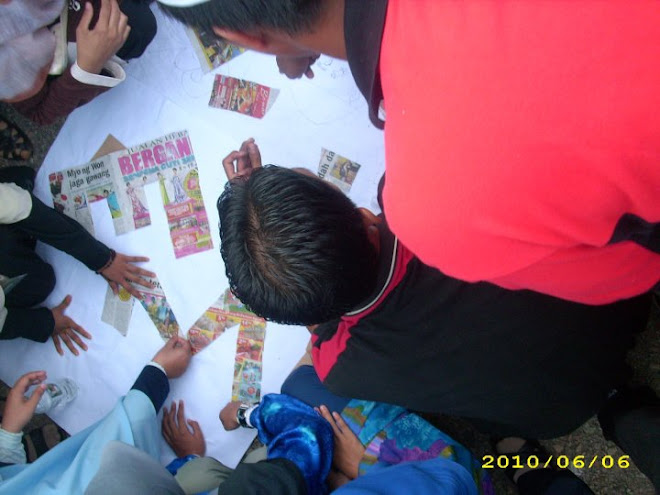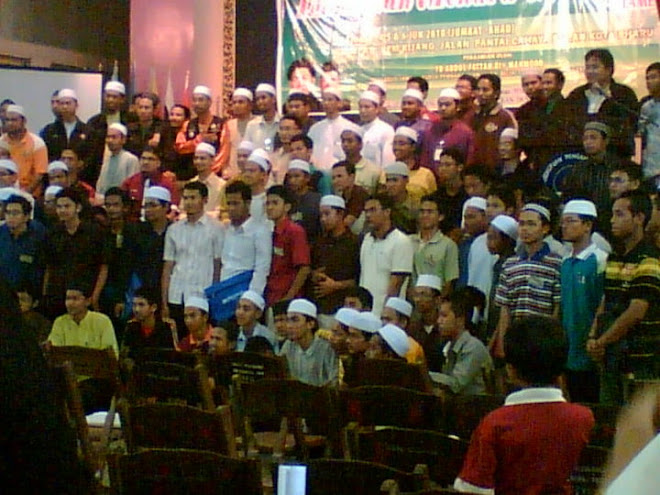Bersihkanlah Dirimu Sebelum Kamu Dimandikan...
Berwudhu'lah Kamu Sebelum Kamu Diwudhu'kan..
Bersolatlah Kamu Sebelum Kamu Disolatkan..
Tutuplah Rambutmu Sebelum Rambutmu Ditutupkan..
Dengan Kain Kafan Yang Serba Putih!
Pada Waktu Itu Tidak Guna Lagi Bersedih..
..Walaupun Orang Yang Hadir Itu Merintih....
Selepas Itu Kamu Akan Diletak Di Atas Lantai..
..Lalu Dilaksanakanlah Solat Jenazah
Dengan Empat Kali Takbir Dan Satu Salam
Berserta Fatihah, Selawat Dan Doa....Sebagai Memenuhi Tuntutan Fardhu Kifayah
Tapi Apakah Empat Kali Takbir Itu Dapat Menebus.
..Segala Dosa Meninggalkan Solat Sepanjang Hidup?
Apakah Solat Jenazah Yang Tanpa Rukuk Dan Sujud..
..Dapat Membayar Hutang Rukuk Dan Sujudmu Yang Telah Luput?
Sungguh Tertipulah Dirimu Jika Beranggapan Demikian....
Justeru Ku Menyeru Sekelian Muslimin Dan Muslimat..
..Usunglah Dirimu Ke Tikar Solat..
..Sebelum Kamu Diusung Ke Liang Lahad..
..Menjadi Makanan Cacing Dan Mamahan Ulat...
Iringilah Dirimu Ke Masjid.
...Sebelum Kamu Diiringi Ke Pusara..
Tangisilah Dosa-Dosamu Di Dunia..
..Kerana Tangisan Tidak Berguna Lagi Di Alam Baqa'..
Sucikanlah Dirimu Sebelum Kamu Disucikan..
Sedarlah Kamu Sebelum Kamu Disedarkan..
..Dengan Panggilan 'Izrail Yang Menakutkan..
Berimanlah Kamu Sebelum Kamu Ditalqinkan..
Kerana Ianya Berguna Untuk Yang Tinggal....Bukan Yang Pergi..
Beristighfarlah Kamu Sebelum Kamu Diistighfarkan..
Namun Ketika Itu Istighfar Tidak Menyelamatkan..
Ingatlah Di Mana Saja Kamu Berada..
..Kamu Tetap Memijak Bumi Tuhan..
Dan Dibumbungi Dengan Langit Tuhan..
Serta Menikmati Rezeki Tuhan..
Justeru Bila Dia Menyeru,....Sambutlah Seruan-Nya
Sebelum Dia Memanggil Mubuat Kali Yang Terakhirnya...
Ingatlah Kamu Dahulu Hanya Setitis Air Mani Yang Tidak Bererti...
Lalu Menjadi Segumpal Darah..
Lalu Menjadi Seketul Daging...
Lalu Daging Itu Membaluti Tulang..
Lalu Jadilah Kamu Insan Yang Mempunyai Erti....
Ingatlah Asal Usulmu Yang Tidak Bernilai Itu..
..Yang Kalau Jatuh Ke Tanah Ayam Tak Patuk, Itik Tak Sudu...
Tapi Allah Mengangkatmu Ke Suatu Mercu..
..Yang Lebih Agung Dari Malaikat..
Lahirmu Bukan Untuk Dunia..
..Tapi Gunakanlah Ia Buat Melayar Bahtera Akhirat..
Sambutlah Seruan 'Hayya 'Alas Solaah'..
..Dengan Penuh Rela Dan Bersedia!
Sambutlah Seruan 'Hayya 'Alal Falaah'..
..Jalan Kemenangan Akhirat Dan Dunia...
Ingatlah Yang Kekal Ialah Amal..
..Menjadi Bekal Sepanjang Jalan...
Menjadi Teman Di Perjalanan..
..Guna Kembali Ke Pangkuan Tuhan...
Pada Hari Itu Tiada Berguna..
..Harta, Tahta Dan Putera..
..Isteri, Kad Kredit Dan Kereta..
..Kondominium, Saham Dan Niaga..
..Kalau Dahi Tak Mencecah Sejadah Didunia..
Sabtu, 12 Mac 2011
Dahi Cecah Ke Sejadah ..
Tsunami at japan 11-3-2011
Assalamualaikum...
سْــــــــــــــمِ اللهِ الرَّحْمَنِ الرَّحِيْـــــمِ
TOKYO: The biggest earthquake to hit Japan since records began 140 years ago struck the northeast coast on Friday, triggering a 10-metre tsunami that swept away everything in its path, including houses, ships, cars and farm buildings on fire.
The Red Cross in Geneva said the wall of water was higher than some Pacific islands and a tsunami warning was issued for the whole of the Pacific basin, except for the United States and Canada, but Hawaii ordered the evacuation of coastal areas.
At least 22 people were killed in the quake and tsunami, Kyodo news agency said, and the extent of the destruction, and the forecast for the tsunami, suggested the death toll could rise significantly.
The 8.9 magnitude quake caused many injuries, sparked fires and the wall of water, prompting warnings to people to move to higher ground in coastal areas.
“I was terrified and I’m still frightened,” said Hidekatsu Hata, 36, manager of a Chinese noodle restaurant in Tokyo’s Akasaka area. “I’ve never experienced such a big quake before.”
Some nuclear power plants and oil refineries were shut down and a refinery and a major steel plant was ablaze.
Cabinet ministers were meeting about nuclear issues after media reports said the government would declare a nuclear power emergency, which occurs if there is confirmation of radioactivity leaks or a reactor cooling system breakdown.
Around 4.4 million homes were without power in northern Japan, media said. A hotel collapsed in the city of Sendai and people were feared buried in the rubble.
Electronics giant Sony Corp , one of the country’s biggest exporters, shut six factories, Kyodo reported, as air force jets raced toward the northeast coast to determine the extent of the damage.
The Bank of Japan, which has been struggling to boost the anaemic economy, said it would do its utmost to ensure financial market stability as the yen and Japanese shares fell.
The Philippines, Taiwan and Indonesia all issued tsunami alerts, reviving memories of the giant tsunami which struck Asia in 2004. The Pacific Tsunami Warning Center issued alerts for countries to the west and across the Pacific as far away as Colombia and Peru.
There were several strong aftershocks. In Tokyo, buildings shook violently. An oil refinery near the city was on fire, with dozens of storage tanks under threat.
Stunning TV footage showed the tsunami carrying the debris and fires across a large swathe of coastal farmland near the city of Sendai, which has a population of one million. Ships in once coastal area were lifted from the sea into a harbour where they lay helplessly on their side.
Sendai is 300 km (180 miles) northeast of Tokyo and the epicentre at sea was not far away.
NHK showed flames and black smoke billowing from a building in Odaiba, a Tokyo suburb, and bullet trains to the north of the country were halted.
Thick smoke was also pouring out of an industrial area in Yokohama’s Isogo area. TV footage showed boats, cars and trucks tossed around like toys in the water after a small tsunami hit the town of Kamaichi in northern Japan. An overpass, location unknown, appeared to have collapsed and cars were turning around and speeding away.
Kyodo news agency said there were reports of fires in Sendai where waves carried cars across the runway at the airport.
“The building shook for what seemed a long time and many people in the newsroom grabbed their helmets and some got under their desks,” Reuters correspondent Linda Sieg said in Tokyo.
“It was probably the worst I have felt since I came to Japan more than 20 years ago.”
The quake struck just before the Tokyo stock market closed, pushing the Nikkei down to end at a five-week low. Nikkei futures trading in Osaka tumbled as much as 4.7 percent in reaction to the news.
The disaster also weighed on markets elsewhere, pushing shares in European insurance companies down. Large reinsurers, Swiss Re , Hannover Re and Munich Re, were all down more than 4 percent.
British, French and German insurers were also sold off in early trade, with Aviva down more than 2 percent, Allianz off 1.7 percent and Axa 1.3 percent lower.
Great Kanto quake
The quake was the biggest in 140 years. It surpasses the Great Kanto quake of Sept. 1, 1923, which had a magnitude of 7.9, killed more than 140,000 people in the Tokyo area. Seismologists had said another such quake could strike the city any time.
The 1995 Kobe quake caused $100 billion in damage and was the most expensive natural disaster in history. Economic damage from the 2004 Indian Ocean tsunami was estimated at about $10 billion.
The Tokyo stock market extended losses after the quake. The central bank said it would do everything to ensure financial stability.
Passengers on a subway line in Tokyo screamed and grabbed other passengers’ hands during the quake. The shaking was so bad it was hard to stand, said Reuters reporter Mariko Katsumura.
Hundreds of office workers and shoppers spilled into Hitotsugi street, a shopping street in Akasaka in downtown Tokyo.
Household goods ranging from toilet paper to clingfilm were flung into the street from outdoor shelves in front of a drugstore.
Crowds gathered in front of televisions in a shop next to the drugstore for details. After the shaking from the first quake subsided, crowds were watching and pointing to construction cranes on an office building up the street with voices saying, “They’re still shaking!”, “Are they going to fall?”
Asagi Machida, 27, a web designer in Tokyo, sprinted from a coffee shop when the quake hit.
“The images from the New Zealand earthquake are still fresh in my mind so I was really scared. I couldn’t believe such a big earthquake was happening in Tokyo.”
The US Geological Survey earlier verified a magnitude of 7.9 at a depth of 15.1 miles and located the quake 81 miles east of Sendai, on the main island of Honshu. It later upgraded it to 8.9.
A police car drove down Hitotsugi Street, lights flashing, announcing through a bullhorn that there was still a danger of shaking.
Japan’s northeast Pacific coast, called Sanriku, has suffered from quakes and tsunamis in the past and a 7.2 quake struck on Wednesday. In 1933, a magnitude 8.1 quake in the area killed more than 3,000 people. Last year fishing facilities were damaged after by a tsunami caused by a strong tremor in Chile.
Earthquakes are common in Japan, one of the world’s most seismically active areas. The country accounts for about 20 percent of the world’s earthquakes of magnitude 6 or greater.
The Red Cross in Geneva said the wall of water was higher than some Pacific islands and a tsunami warning was issued for the whole of the Pacific basin, except for the United States and Canada, but Hawaii ordered the evacuation of coastal areas.
At least 22 people were killed in the quake and tsunami, Kyodo news agency said, and the extent of the destruction, and the forecast for the tsunami, suggested the death toll could rise significantly.
The 8.9 magnitude quake caused many injuries, sparked fires and the wall of water, prompting warnings to people to move to higher ground in coastal areas.
“I was terrified and I’m still frightened,” said Hidekatsu Hata, 36, manager of a Chinese noodle restaurant in Tokyo’s Akasaka area. “I’ve never experienced such a big quake before.”
Some nuclear power plants and oil refineries were shut down and a refinery and a major steel plant was ablaze.
Cabinet ministers were meeting about nuclear issues after media reports said the government would declare a nuclear power emergency, which occurs if there is confirmation of radioactivity leaks or a reactor cooling system breakdown.
Around 4.4 million homes were without power in northern Japan, media said. A hotel collapsed in the city of Sendai and people were feared buried in the rubble.
Electronics giant Sony Corp , one of the country’s biggest exporters, shut six factories, Kyodo reported, as air force jets raced toward the northeast coast to determine the extent of the damage.
The Bank of Japan, which has been struggling to boost the anaemic economy, said it would do its utmost to ensure financial market stability as the yen and Japanese shares fell.
The Philippines, Taiwan and Indonesia all issued tsunami alerts, reviving memories of the giant tsunami which struck Asia in 2004. The Pacific Tsunami Warning Center issued alerts for countries to the west and across the Pacific as far away as Colombia and Peru.
There were several strong aftershocks. In Tokyo, buildings shook violently. An oil refinery near the city was on fire, with dozens of storage tanks under threat.
Stunning TV footage showed the tsunami carrying the debris and fires across a large swathe of coastal farmland near the city of Sendai, which has a population of one million. Ships in once coastal area were lifted from the sea into a harbour where they lay helplessly on their side.
Sendai is 300 km (180 miles) northeast of Tokyo and the epicentre at sea was not far away.
NHK showed flames and black smoke billowing from a building in Odaiba, a Tokyo suburb, and bullet trains to the north of the country were halted.
Thick smoke was also pouring out of an industrial area in Yokohama’s Isogo area. TV footage showed boats, cars and trucks tossed around like toys in the water after a small tsunami hit the town of Kamaichi in northern Japan. An overpass, location unknown, appeared to have collapsed and cars were turning around and speeding away.
Kyodo news agency said there were reports of fires in Sendai where waves carried cars across the runway at the airport.
“The building shook for what seemed a long time and many people in the newsroom grabbed their helmets and some got under their desks,” Reuters correspondent Linda Sieg said in Tokyo.
“It was probably the worst I have felt since I came to Japan more than 20 years ago.”
The quake struck just before the Tokyo stock market closed, pushing the Nikkei down to end at a five-week low. Nikkei futures trading in Osaka tumbled as much as 4.7 percent in reaction to the news.
The disaster also weighed on markets elsewhere, pushing shares in European insurance companies down. Large reinsurers, Swiss Re , Hannover Re and Munich Re, were all down more than 4 percent.
British, French and German insurers were also sold off in early trade, with Aviva down more than 2 percent, Allianz off 1.7 percent and Axa 1.3 percent lower.
Great Kanto quake
The quake was the biggest in 140 years. It surpasses the Great Kanto quake of Sept. 1, 1923, which had a magnitude of 7.9, killed more than 140,000 people in the Tokyo area. Seismologists had said another such quake could strike the city any time.
The 1995 Kobe quake caused $100 billion in damage and was the most expensive natural disaster in history. Economic damage from the 2004 Indian Ocean tsunami was estimated at about $10 billion.
The Tokyo stock market extended losses after the quake. The central bank said it would do everything to ensure financial stability.
Passengers on a subway line in Tokyo screamed and grabbed other passengers’ hands during the quake. The shaking was so bad it was hard to stand, said Reuters reporter Mariko Katsumura.
Hundreds of office workers and shoppers spilled into Hitotsugi street, a shopping street in Akasaka in downtown Tokyo.
Household goods ranging from toilet paper to clingfilm were flung into the street from outdoor shelves in front of a drugstore.
Crowds gathered in front of televisions in a shop next to the drugstore for details. After the shaking from the first quake subsided, crowds were watching and pointing to construction cranes on an office building up the street with voices saying, “They’re still shaking!”, “Are they going to fall?”
Asagi Machida, 27, a web designer in Tokyo, sprinted from a coffee shop when the quake hit.
“The images from the New Zealand earthquake are still fresh in my mind so I was really scared. I couldn’t believe such a big earthquake was happening in Tokyo.”
The US Geological Survey earlier verified a magnitude of 7.9 at a depth of 15.1 miles and located the quake 81 miles east of Sendai, on the main island of Honshu. It later upgraded it to 8.9.
A police car drove down Hitotsugi Street, lights flashing, announcing through a bullhorn that there was still a danger of shaking.
Japan’s northeast Pacific coast, called Sanriku, has suffered from quakes and tsunamis in the past and a 7.2 quake struck on Wednesday. In 1933, a magnitude 8.1 quake in the area killed more than 3,000 people. Last year fishing facilities were damaged after by a tsunami caused by a strong tremor in Chile.
Earthquakes are common in Japan, one of the world’s most seismically active areas. The country accounts for about 20 percent of the world’s earthquakes of magnitude 6 or greater.
Langgan:
Ulasan (Atom)














































 Get More Islamic Testi Here!
Get More Islamic Testi Here!